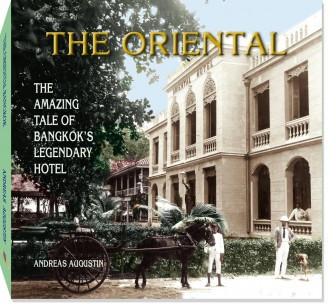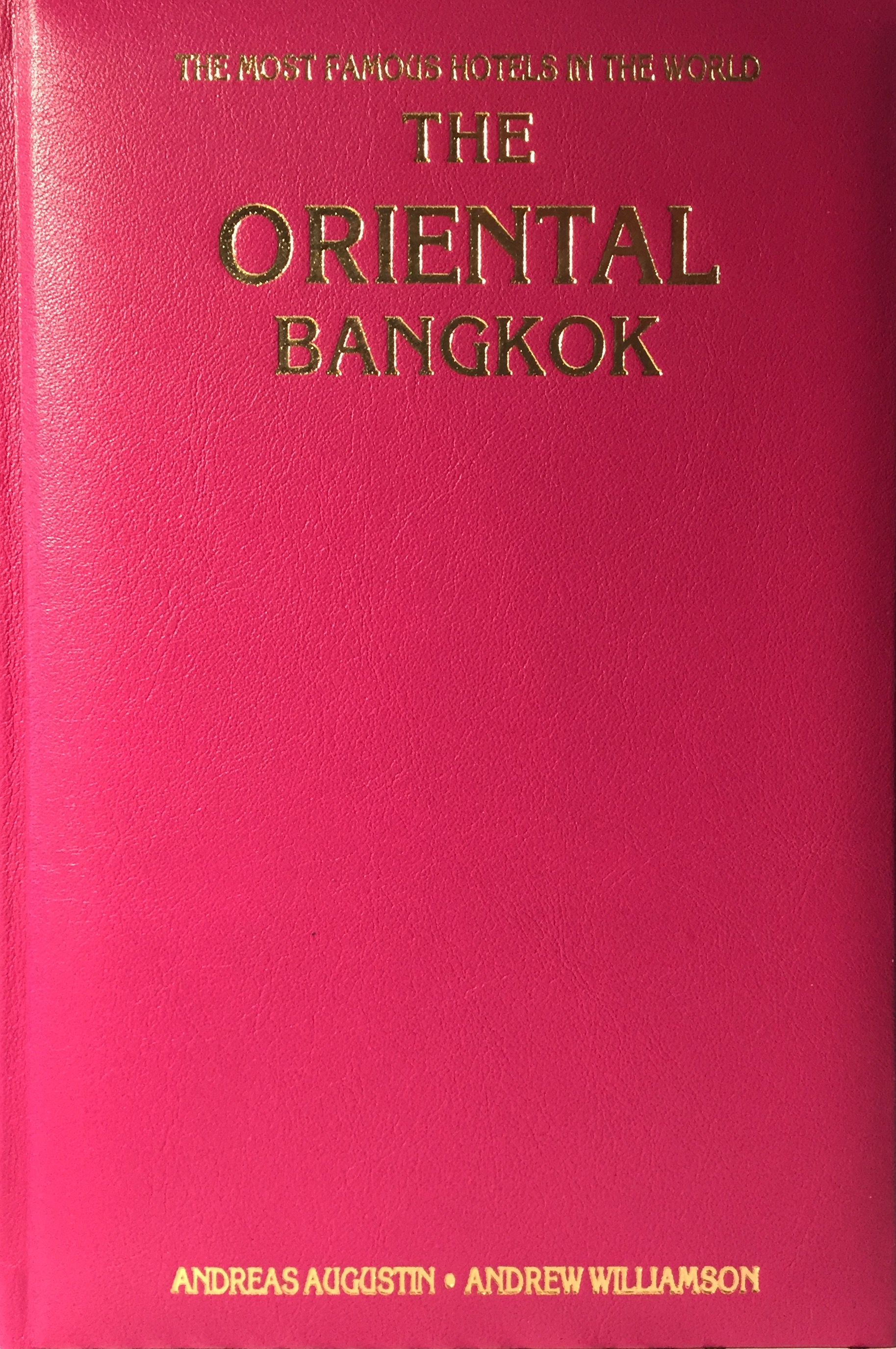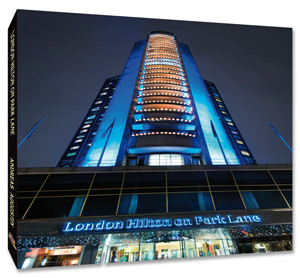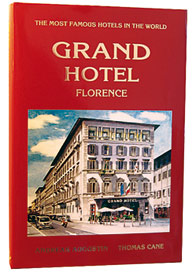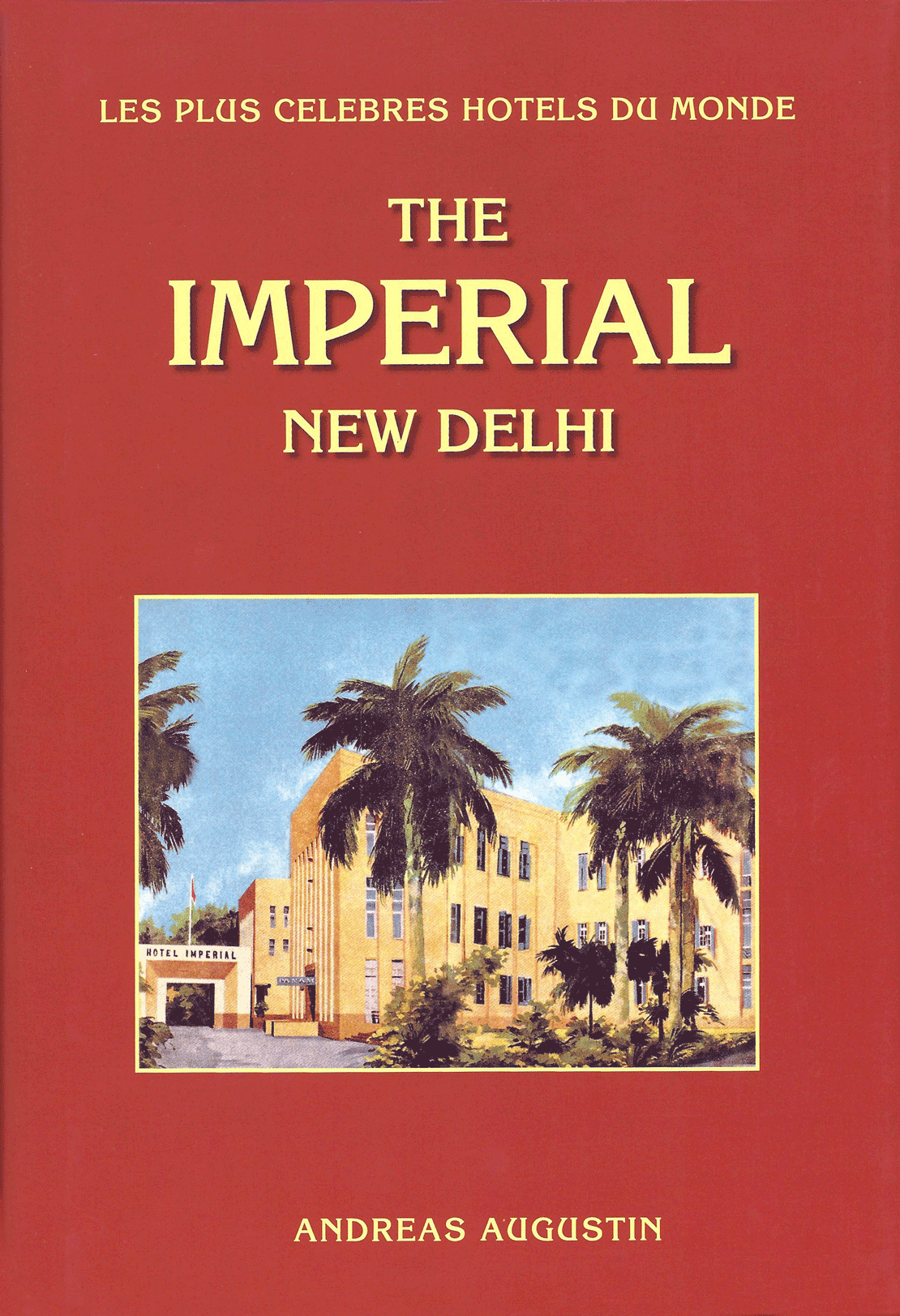The Mena House Treasury – Cairo, Egypt (English)
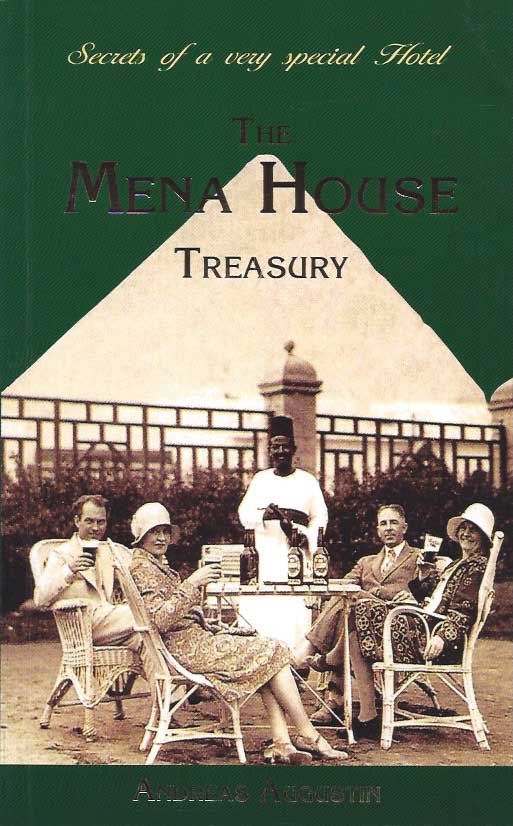
Author
Andreas Augustin
Pages
88
Photographs
Illustrations
over 240 historic and contemporary photographs and illustrations
Leather-bound edition
No
Binding
Paperback
Includes
2 postcards, 2 reading marks for HIM and HER
ISBN
3-900692-14-9
Size/Weight
132 x 210 mm, 225 g
Related Hotel
Price: € 22.00
Add to cartDuring the 1880s, an oriental palace rose in stone and mortar from the desert, decorated by the most lavish interior design ever seen. The Mena House, born as a luxurious hotel on grounds famous for hospitality since the opening of the Suez Canal in 1869, became the jewel in the crown of the greatest legends of the Orient.
This book is the result of a years long research and documentation project. It is the only authroised biography of the house at the edge of the great North African desserts, at the foot of the Great Pyramids.
It tells the story and delves into the fascinating past of Egypt. Learn about the Pyramids & Hieroglyphics, the building of the Suez Canal, the true story of Aida, the Seven Wonders of the Ancient World and the best anecdotes the grand old lady Mena House has to tell. Featuring: HIH the Crown Prince of Japan, Peace Conference Sadat and Carter, HRH the King of Sweden, Gloria Gaynor, HH Prince Aga Khan, Omar Sharif. Centre: Peace conference Chiang Kai Shek, Roosevelt and Churchill; Right: HRH Sofia and Juan Carlos of Spain, Chaplin, Sinatra and Roger Moore.
Mornings at the Mena House are tennis or golf; mornings are swimming; mornings are a cup of fresh peppermint tea at the lobby bar. A brisk walk up the ramp to the Great Pyramid is a wonderful morning exercise.
Producing a book like the Mena House Treasury is a matter of years of research, comparable to an archaeological dig. In this case we were chal- lenged to verify an age-old legend: the story that the Mena House was built on the spot where once stood an old Khedival hunting lodge.
The project started right here in Gizah, where we combed the premises for clues to the past. We discovered an ancient door still functioning today, which can be traced back to the year 1885, when today’s hotel was built. We knew that we were closing in on the former hunting lodge, but we were still not quite there. We spent weeks in the archives of The Egyptian Gazette, unearthing dusty old newspaper articles about the early days of the hotel. We travelled to Paris to search the Archives Diplomatiques at the Quai d’Orsay. In London, the Imperial War Museum, usually a great source, came up with nothing. Vienna and Austria’s long-lasting relations with Egypt produced valuable archival material. But still the elusive hunting lodge described in countless books and articles remained a mystery.
One day, the door to the past suddenly creaked open. In an attic in the North of Scotland, in the house of a great-granddaughter of the first manager of the hotel, our torch beams shone upon fading photographs hidden away for over one hundred years. For the first time, we came across an image of the ‘mud hut’. It showed a fine two-storey building, fitting exactly the description of the fabled hunting lodge after various extension.
The building (right) stood to the North of the first Mena House, about one hundred metres from the famous mosque-shaped restaurant Al Rubayyat. It remained the private quarters of the hotel’s owners and its first manager, Ernst Rodakowski. During the extensions built between 1950 and 1978, the structure was demolished and replaced by one of the Garden Wings of the hotel. The hunting lodge accommodated guests of the Khedive ever since 1869, the year the Suez Canal opened. Mission accomplished; back to the Mena House.
The Mena House always was a destination in its own right. Some used to spend the entire winter here. Most comfortably located, right outside of Cairo and it’s treasures, next to the Great Pyramid, with the fresh and clean air of the desert. At lunch Zahi Hawass, Secretary General of the Supreme Antiques Council of Egypt, confesses that it was at the Mena House that he was nursed back to life after a heart attack.
Evenings are for cocktails. Evenings are for the best Indian food west of Mumbai. Evenings are for barbecues at Oasis beside the pool. Later I sit on my little balcony and gaze at the Pyramid. I actually stare. Every day, every night, I stare at the Great Pyramid, waiting for something to happen.
Every time, I think to discover new shades, new facets in this giant pile of stones. Every time I sit and wait for something to happen, and in the end I realise that eternity is like the proverbial water kettle: nothing happens while you watch.
The Most Famous Hotels in the World: The Mena House, Egypt
Some of the greatest and most legendary hotels stand in Egypt. The greatest of them all, the Mena House, commissioned us to research and write its history. We were confronted with many legends, interesting stories, a 50 years old history book and the great question: When did our hotel really open? In the shadow of the Great Pyramid we started digging, like Howard Carter in 1922. We didn't find Tutankhamun, but we found the truth.
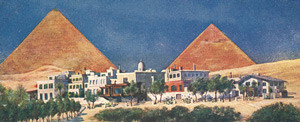
I mentioned this before: it is not always easy to accept the truth. This photograph, as we found out, doesn't date back to 1869, but to 1886, the true opening year of the Mena House.
________________________________
The Mena House Legend
by Andreas Augustin
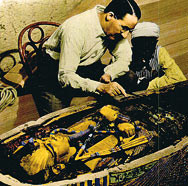 Producing a book like the Mena House hotel's history is a matter of years of research, comparable to an archaeological dig (left: Howard Carter) .
Producing a book like the Mena House hotel's history is a matter of years of research, comparable to an archaeological dig (left: Howard Carter) .
In this case we were challenged by former general manager Rajiv Kaul to verify two age-old legends: the story that the Mena House was built on the spot where once stood an old Khedival hunting lodge, and that it had been pened in 1869, the year the Suez Canal opened.
In some historic hotels there are very special people working. They have developed a passion for their hotel's history. They are amateur archivists and history custodians, without being specially assigned to do such a job. They are simply passionate about their hotel's past. They collect photographs, labels and other memorabilia.
Needless to say - we love those people!
At the Mena House it was the Assistant Director of Sales & Marketing, Tarek Lotfy. He had started collecting material many years back. His office at the hotel in Gizah, opposite the Great Pyramid, had become the hotel's archives. He in return was happy to be offered professional assistance in dating various unverified photographs and other material.
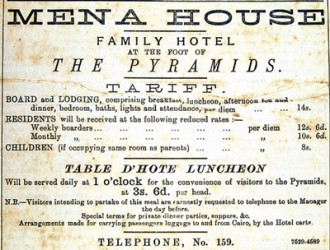
marketing concepts. This ad dates from 1888.
_____________________________________
We combed the premises for clues to the past. We discovered an ancient door still functioning today (right), which could be traced back to the year 1885, when today’s hotel was built. We spotted elements matching old photographs, which we were able to date using genealogical research techniques. Here we were following the leads to uncover the truth usually hidden in some elements of the photograph (the date is always in the details.)We knew that we were closing in on the former hunting lodge, but we were still not quite there. We spent weeks in the archives of The Egyptian Gazette, Cairo's first English newspaper, going through dusty folders of all newspapers published since 1880. We were unearthing faded old articles about the early days of the hotel. We narrowed the choice of opening dates down to a few possible years,We visited the local museum and collections, browsed various archives between Beirut and Alexandria. We travelled to Paris to search the Archives Diplomatiques at the Quai d’Orsay. In London, the Imperial War Museum, usually a great source, came up with nothing. Austria’s long-lasting relations with Egypt produced valuable archival material at the Voelkerkundemuseum in Vienna. But still the elusive hunting lodge described in countless books and articles remained a mystery.
One day, the door to the past suddenly creaked open. In an attic in the North of Scotland, in the house of a great-granddaughter of the first manager of the hotel, our torch beams shone upon remarkably well kept photographs hidden away for over one hundred years. For the first time, we came across an image of the ‘mud hut’. It showed a fine two-storey building, fitting exactly the description of the fabled hunting lodge.
The building stood to the North of the first Mena House, about one hundred metres from its mosque-shaped restaurant Al Rubayyat. It remained the private quarters of the hotel’s owners and its first manager, Ernst Rodakowski. During the extensions built between 1950 and 1978, the structure was demolished and replaced by one of the Garden Wings of the hotel. The hunting lodge accommodated guests of the Khedive ever since 1869, the year the Suez Canal opened. Mission accomplished; back to the Mena House.
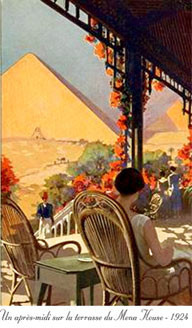
But when did the Mena House open? We found the private diary of the first manager. His entries confirmed the various announcements we had found in the Egyptian Gazette. A new date, which is now the official opening date of the Mena House in Cairo: 1886!
With more sources tapped, the romantic stories of the hotel unfolded. The Mena House really has seen all and everybody who ever travelled to Egypt to visit the Pyramids. Some used to spend the entire winter here. Most comfortably located, right outside of Cairo and it’s treasures, next to the Great Pyramid, with the fresh and clean air of the desert. Since decades the largest swimming pool of the country, floodlight tennis courts and an 18 holes golf course in the shadow of the Great Pyramid lures clients to the hotel.
_____________________
Andreas Augustin
presents
The Mena House Treasury
the Reader’s digest’ of MENA HOUSE in the series
THE MOST FAMOUS HOTELS IN THE WORLD®
Photographs and sources: The Most Famous Hotels archives, American University Beirut, Claude Stemmelin, the private collections of Eloui Farid and Mahmoud Abdel Kader, the Rodakowski estate, Nina Nelson, Tom Shipley, Xandra Hurlingham, Mohamed Khattab, Francis Amin, L’Orientale; Lehnert & Landrock; The Egyptian Gazette Archives; Al-Ahram.
Special thanks to Sanjiv Malhotra and Rajiv Kaul for making this project possible, Nabil Sobhy, Ann Moukhtar Kortam, Veneeta Rikhy, Kamal Zayton, Atef Goubran, Nagla Sakr, Noha Ihab and last but not least to Ashraf Gabry.
Tarek Lotfy deserves mentioning for keeping track of historical archives
Carola and Florian Augustin for days of researching in dusty archives in Cairo.
All rights reserved. No part of this book may be reproduced, stored in a retrieval system or transmitted in any form or by any means, electronically, mechanical, photocopying, recording, or otherwise without the prior permission in writing of the copyright owner.
A history project conducted by
The Most Famous Hotels in the World™
Famous Hotels Main Archives
www.famoushotels.org
ISBN: 3-900692-14-9
© Andreas Augustin
Editorial control: Thomas Cane Carola Augustin
Design Ramazotti Michelangelo

